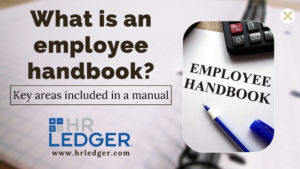An Employee Handbook Can Be The Most Effective Tool To Run Your Company Smoothly
What is an employee handbook?
It’s an opportunity to introduce your company to your newly hired employee. The manual sets a precedent for how the employee will be treated, what the company expects from them, and what they should expect from the company. It protects the company from potential legal actions as well by covering the legal obligations of the company and the legal rights of the employee.
While California does not require companies to have an employee handbook, the Fair Employment and Housing Act (FEHA) requires California employers with five employees or more to distribute a written harassment, discrimination, and retaliation prevention policy. So why not include them in your manual?
There are other general policies that may be required of a company by the state or local government. For example, California requires a Payroll Practices and Compensation Policy as well as a Workday and Workweek Notice. For the most part, however, the employee manual is company specific.
The first section of your handbook is all about your company. It should inform the employee of your company’s mission and values, as well as leave the new hire with an impression and clear understanding of company culture that inspires them to get to work.
The remainder of the handbook needs to establish effective and long lasting communication channels, set expectations, and clearly delineate responsibilities involving both employees and the company.
Start with the basics. In your company’s manual you should have a clear description of each of the following sections: Company at a glance (history, vision, mission statement, core values), employment basics (hours, dress code, etc), workplace policies, Code of Conduct, Compensation and development, Benefits and Perks, PTO and Vacation, Employee Resignation and Termination. Additional sections could include: non-compete or NDAs. The final page should be a place for the employee to sign in acknowledgement that they received your company handbook, have fully read it, understand what is expected of them, and agree to abide by the policies within.
While compiling your company manual you should consider what you would want if you were the employee. How would you like to be treated?
Let’s take a quick moment to go over a few details in regards to the minimum suggested requirement of an employee manual.
Keep in mind that the more topics you cover and detail you go into within the manual the more consistent your employees and management can be. This will be an essential tool for your HR team, in-house or outsourced.
California Specific policies:
The Payroll Practices and Compensation Policy is a great place to start setting those expectations for both employee and employer. This policy covers the payment of wages, deductions from wages, exempt employees, timekeeping (including off-the clock prohibitions), overtime, breaks for nursing mothers, on-call time, and procedures for employee complaints in regards to wage and work hours. This is a good section to add any local laws that apply to wages and hours. Additional company specific wage and hour policies may be included as long as they are compliant with California & federal law. Don’t forget the basics: how to clock in and out, who to call in the event of an unplanned absence, how to request vacation, etc.
Workday and Workweek Notice should also be included in your handbook. In this section you will clarify the hour that starts a 24 hour period, further referred to as a day. This sets the basis in which overtime is accrued. Another aspect of this policy is the 40 hour workweek in conjunction with overtime accrual as well as alternative schedule arrangements for field specific employees and exemption clauses.
Standard minimums:
Statement of Pay period, paydays and times as well as where the checks are to be picked up.
Make up time policy – Does your company offer make up time in the event an employee takes time off and wants to make up for it another day of the week? If so, use this section to expand on the process of requesting makeup time as well as the difference between makeup time and overtime.
Benefits offered – PTO, 401K, health insurance, stock options etc, paid leave, FMLA, military leave. Make sure to communicate all the details here including eligibility.
A policy that details the procedure and reward structure for an Employee Referral.
There should be a section that addresses how to exit the area/building in event of a disaster or emergency. Include where the exits are, where to form up once safely outside the area/building, and when employees can be excused from work. Stress doing so calmly and efficiently.
The next three are incredibly important not only legally but in order to set those clear expectations. Make sure to name one or two people in the company that they can go to for help and advice in the below situations. The person or people listed should be in a management role and have the capacity to empathize and remain level headed while helping to navigate a potential situation.
A written Harassment Policy that clearly states what is considered harassment, what level of tolerance your company has for it, and the punishment for this behavior.
A Discrimination Policy that defines discrimination, and what that behavior looks like. Clear explanations for both discrimination from the company and discrimination as an employee.
A Retaliation Prevention Policy in which any retaliation from within the company will not be tolerated. You want the employee to feel comfortable that they will not be retaliated against. While simultaneously stating that if they retaliate against another employee they will be terminated.
Your employee handbook is your greatest tool to protect your company and your employees.
Still feeling overwhelmed and underqualified, or just lacking the time needed to dedicate to this task? HR Ledger is here to help. This is our wheelhouse, we stay up to date with legal terminology and California requirements. Already have an employee handbook but are afraid it’s outdated or lacking in some way? We are happy to step in and update you accordingly. Have an employee who isn’t upholding their end of the bargain and is unsure of how to proceed properly? Our staff is available to assist with all HR needs.
HR Ledger can help.
Please call Malcolm or Scott today at 800-451-1136.





